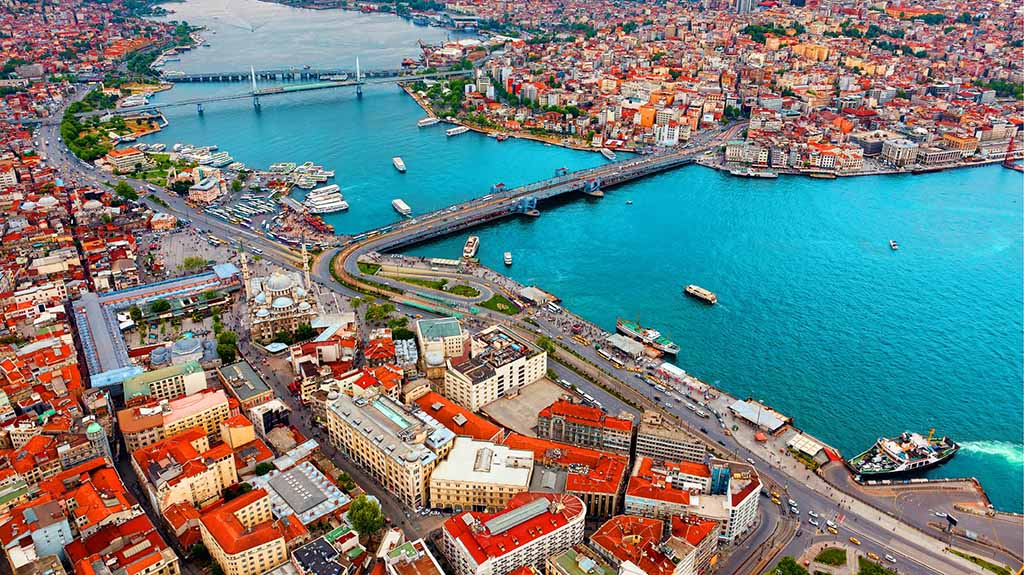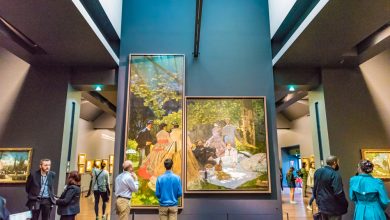Galata Tower: Istanbul’s Timeless Wonder

Discover the architectural wonders of Galata Tower, a historical masterpiece in Istanbul, and witness the enchanting fusion of medieval charm and modern allure that defines this remarkable structure.
The Galata Tower is a historic stone tower located in the Galata neighborhood of Beyoglu in Istanbul. It stands on the European side of the city, near the Golden Horn, and has become an iconic symbol of Istanbul’s skyline. The Galata Tower played a crucial role as a symbol of prestige and a defense structure in history with its strategic position and magnificence. Its construction was part of the fortifications providing an elevated position for surveillance and observation in those times.
Apart from its strategic significance, the Galata Tower holds cultural and social importance for the people of Istanbul. It has been featured in numerous literary works, poems, songs, myths, and paintings throughout history, symbolizing the city’s rich heritage and beauty. Today, it is a popular tourist attraction and welcomes thousands of visitors every year for the ones who want to see the entire city from a panoramic view on its observation deck.
The tower can be visited every day between 08:30 am to 11:00 pm and the entrance fee is 350 Turkish liras (2023). To not wait a lot in the queue of entrance you may have your Galata tower tickets online. Having a museum card (either a museum pass Istanbul or Istanbul e-pass) beforehand is also recommended if you are planning to visit the other museums and historical places in Istanbul. It is also possible to have a guided Galata tower tour.
The Galata Tower continues to represent the city’s rich past offering a chance to appreciate its architectural beauty while enjoying breathtaking views of one of the world’s most vibrant and culturally significant cities, and waiting to be visited by you!
Contents
Historical Significance of Galata Tower
The tower’s construction and original purpose during the medieval period
The Galata Tower has a long history dating back several centuries. It was initially built in the 6th century by the Byzantine Emperor Justinianos and was called the “Megalos Pyrgos” or Great Tower. In the 14th century, it was rebuilt by the Genoese, an Italian trading colony in Constantinople (now Istanbul), and named the “Christea Turris” or Tower of Christ. The tower served as a defensive structure for the Genoese, helping them protect their control over the area and their commercial interests. It functioned as a watchtower to monitor and defend the entrance to the Golden Horn, an important harbor and trade route.
After the conquest of Istanbul, the tower was handed over to the Ottomans in 1453. During the Ottoman era, it continued to serve similar purposes but was no longer a central defense structure. Instead, the Ottomans had developed other fortifications to secure the city. The tower was used as a watchtower, fire lookout, and occasionally as a prison. However, its primary function was as an observation tower, offering panoramic views of Istanbul.
Throughout its history, the Galata Tower underwent various renovations and restorations. The most significant reconstruction took place in the 16th century after a severe fire. The Ottomans rebuilt it, adding a conical roof and a balcony, which enhanced its unique appearance.
The Galata Tower is a symbol of power and prestige, witnessing the transformation of Istanbul over the centuries. Its design and architectural elements reflect the city’s rich cultural heritage and architectural legacy.
Its role as a defense structure and a symbol of power and prestige
As a defense structure, the Galata Tower had importance due to its location. Because it is positioned on a hill, the tower offered an advantageous vantage point to the area. it served several purposes for protection and defense:
- Watchtower: The Galata Tower served as a watchtower, allowing the Genoese to keep a constant eye over the sea and its surroundings as it has a clear view of the entrance to the Golden Horn. This helped them identify any potential threats, including enemy ships, invading forces, or suspicious activities.Galata Tower
- Communication and Early Warning System: The tower was equipped with a fire beacon system that was used to communicate important messages and warnings. By lighting specific patterns or colors of fire, the Genoese could relay messages to other parts of the city. This early warning system was vital in preventing fires from spreading and minimizing the risks associated with attacks or disasters.
- Architecturally suitable structure for defense: The tower’s fortified walls and sturdy construction made it a powerful defensive structure. It could endure attacks and serve as a safe place for Genoese during times of conflict. Its height and architecture also made it challenging for adversaries to breach or go over the walls.
Apart from its role as a defense structure, the Galata Tower also served as a symbol of power and prestige: - Architectural Splendor: The tower’s imposing height, architectural design, and solid construction indicated the Genoese’s wealth and technical expertise. It was a magnificent structure that symbolized their power and wealth in Istanbul.
- Landmark: The Galata Tower has become an iconic landmark and a symbol of the Genoese presence in Istanbul. It served as a visible reminder of their dominance over the Galata district. After the Galata Tower lost its significance as a symbol of Genoese power, it gained importance as an emblem of Istanbul’s architectural legacy.
- Symbol of Urban Development: During its early years, the Galata Tower was one of Istanbul’s tallest structures. Its towering presence in the city skyline symbolized the area’s growth and development.
- Cultural and Historical Importance: The Galata Tower gained cultural and historical significance over time, becoming a symbol of Istanbul’s rich heritage. It has appeared in literature, art, and popular culture, solidifying its status as an enduring symbol of the city.
Architectural Features of Galata Tower
The Galata Tower in Istanbul has a captivating design and architectural elements that have made it a landmark. The tower’s prominence in Istanbul’s skyline is undeniable. Its cylindrical shape and height of around 67 meters (220 feet) make it the longest building in the surrounding area. With its stone walls and conical roof, it is instantly recognizable and adds to Istanbul’s charm and beauty.
The Galata Tower is constructed primarily with stone, which contributes to its solid and robust appearance. The use of stone not only provides durability but also adds a touch of timeless elegance to the tower’s design.
As you climb the Galata Tower, you’ll notice windows strategically placed at different levels. These windows serve a variety of functions, including air circulation, natural light, and, of course, breathtaking views of the city. The observation deck at the top provides a panoramic view of Istanbul’s stunning skyline, allowing visitors to appreciate the city’s beauty from a unique perspective.
While the Galata Tower exemplifies architectural strength and simplicity, it also features decorative details that enhance its aesthetic charm. These include ornamental motifs and carved elements on the exterior, such as arches and decorative bands, adding a touch of intricate beauty to the tower’s overall design.
Tower’s distinctive cylindrical shape and cone-shaped roof
The most distinctive feature of the Galata Tower is its cylindrical shape. Its cylindrical design is meticulously crafted, with smooth and rounded walls that give it a graceful and majestic appearance. Its shape served both functional and symbolic purposes throughout its history. It provided a tactical advantage for defense and surveillance. Its elevated position allowed guards to keep a close eye on the city, monitoring the Golden Horn entrance and protecting the Genoese colony. The tower’s imposing cylindrical form served as a symbol of strength and authority, leaving a lasting impression on Istanbul’s skyline.
The cone-shaped roof was added during a restoration in the 16th century following a fire incident. During restoration, this architectural feature not only restored the tower’s architectural integrity but also added a touch of enchantment. The elegant curves and pointed top of the cone-shaped roof create a harmonious contrast with the cylindrical base, giving the tower a distinct and fascinating silhouette. This architectural element emphasizes the Galata Tower’s significance as a landmark in Istanbul.
Panoramic Views from Galata Tower
The Galata Tower offers breathtaking panoramic views of Istanbul from its observation deck, providing visitors with a remarkable vantage point to admire the city’s beauty. As you ascend the Galata Tower and reach the observation deck, prepare to be fascinated by the 360-degree view of the Istanbul skyline. These panoramic views offer a captivating tapestry of old and new, where ancient architecture coexists peacefully with modern structures.
After you reach the top, the first thing that attracts attention is, of course, the view of the Bosphorus. Its vast expanse of shimmering water, connecting Europe and Asia, immediately captivates you. The waterway is often dotted with various boats, ferries, and ships gracefully navigating, adding to the charm and dynamic atmosphere.
From the Galata Tower, you’ll also have a unique perspective of Istanbul’s cityscape. The patterns of rooftops, the maze-like streets, and the interplay of colors and textures that make up the fabric of the city admire the ones who see them.
Galata Tower’s Surrounding Neighborhood
The Galata Tower’s surrounding neighborhood offers a blend of history, culture, and modernity creating a unique ambiance that is hard to resist. It invites visitors to the vibrant energy of Istanbul, to taste delicious food, shop for unique treasures, and soak up the atmosphere of this captivating district.
There are so many cultural things to do for visitors as well. You’ll find art galleries, theaters, and places for listening live music all over the streets. You can see modern art exhibits and listen to music that suits all kinds of tastes, from traditional Turkish songs to modern tunes. There’s something for everyone who loves art!
-
Bosphorus Strait
One of the most striking features visible from the Galata Tower is the majestic Bosphorus Strait. Stretching between Europe and Asia, this iconic waterway connects the Black Sea to the Sea of Marmara. You can admire the flow of boats and ships, as well as the picturesque shores on both sides of the strait.
-
Golden Horn
From the Galata Tower, you can also see the Golden Horn, a historic waterway and an inlet that has played an important role in Istanbul’s history. Its distinctive horn-like shape is visible as it curves through the heart of the city.
-
Sultanahmet Area
Looking towards the south, you’ll be able to spot the iconic landmarks of the Sultanahmet area. The majestic domes and minarets of the Hagia Sophia, Blue Mosque (Sultan Ahmed Mosque), and Topkapi Palace will catch your eye. These architectural gems serve as a reminder of Istanbul’s rich Byzantine and Ottoman heritage.
-
Istiklal Street
Just a short walk from the Galata Tower, you’ll find Istiklal Avenue, a lively street with a bit of everything. It’s a pedestrian street lined with shops, cafes, restaurants, and historic landmarks. You can explore a mix of stores, from big international brands to small local boutiques that sell clothes, accessories, and more. Istiklal Avenue is also famous for its live music performances. Talented musicians play different styles of music, adding to the lively atmosphere of the area. It’s a great place to stroll, shop, and enjoy the vibrant energy of Istanbul.
- Galata Mevlevi Lodge Museum
Besides the great shops and food, the Galata Tower neighborhood has some interesting cultural places to visit. One of them is the Galata Mevlevihanesi, which used to be a dervish lodge and is now a museum. You can learn about the mystical Mevlevi order and watch the performances of their famous whirling dervishes. It’s a chance to explore the history and philosophy of this spiritual tradition.
-
Istanbul Modern
Another cultural attraction nearby is the Istanbul Modern Museum. Here, you can see contemporary Turkish art and visit exhibitions that showcase the vibrant art scene of Istanbul. The museum’s displays are always changing, so there’s something new to see each time you visit.
Tips, Tickets and More
If you want to visit the Galata Tower, here’s what you need to know about trips and tickets:
- Ticket Information: Tickets can be purchased directly at the Galata Tower gate. Ticket prices can vary, so check the official website or ask locally for the most recent information.
- Hours of Operation: The Galata Tower is open daily, including weekends and holidays from 08:00 AM to 11:00 PM.
- Guided Tours: As part of a longer itinerary or city trip, some travel organizations provide guided tours to the Galata Tower. These tours frequently include historical and cultural information about the tower as well as Istanbul. Tour choices can be found by searching online, contacting local travel agencies, or inquiring with your hotel’s concierge.
- Visits on Your Own: If you want to tour the Galata Tower on your own, simply purchase tickets at the entry and ascend to the observation deck at any time. Signs and information boards often give historical information about the tower.
- Online Booking: Depending on availability, you may be able to book Galata Tower tickets online. If there are any online booking alternatives, check the official website or third-party ticketing services.
- Peak Hours and Crowds: The Galata Tower may be fairly crowded, particularly during peak tourist seasons and weekends. It’s best to go early in the morning or late in the afternoon to avoid long lines. Consider going during the week rather than on weekends for a more calm atmosphere.
In conclusion, the Galata Tower and its surroundings offer a delightful blend of old-world charm and contemporary energy. Visitors can enjoy live music in the streets, indulge in delicious foods and drinks, take in the breathtaking panoramic view from the top of the tower, and immerse themselves in the cozy atmosphere of the neighborhood. It is a must-visit destination that serves to all the senses and promises a memorable experience. Don’t forget to buy your tickets beforehand. Have a nice trip!















